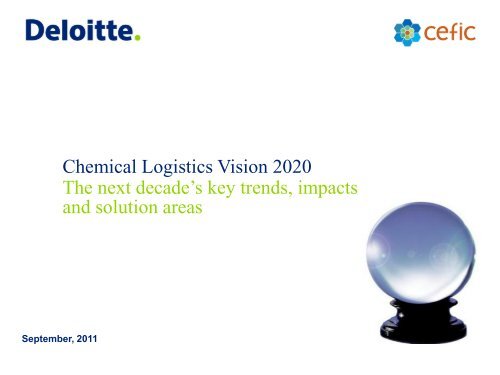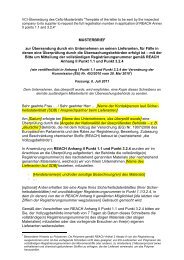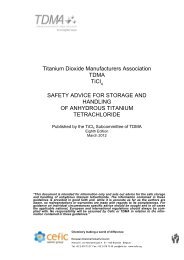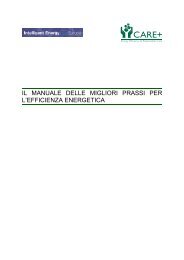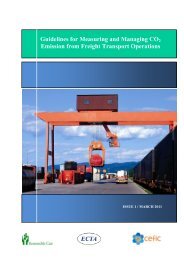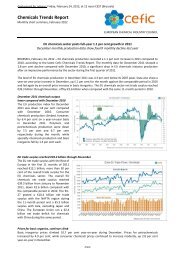Download the report "Chemical Logistics Vision 2020" - Cefic
Download the report "Chemical Logistics Vision 2020" - Cefic
Download the report "Chemical Logistics Vision 2020" - Cefic
You also want an ePaper? Increase the reach of your titles
YUMPU automatically turns print PDFs into web optimized ePapers that Google loves.
<strong>Chemical</strong> <strong>Logistics</strong> <strong>Vision</strong> 2020<br />
The next decade’s key trends, impacts<br />
and solution areas<br />
September, 2011
Introduction<br />
The chemical industry is an important driver of <strong>the</strong> global economy, with estimated global annual sales of €1871 billion in 2009. The EU<br />
remains a leading chemicals production area, valued at €449 billion and accounting for 24 per cent of world chemicals production in<br />
2009. Europe‟s share of <strong>the</strong> global chemicals production dropped however from 32 to 24 per cent between 1999 and 2009, due to<br />
stronger growth in o<strong>the</strong>r parts of <strong>the</strong> world.<br />
<strong>Logistics</strong> are a key aspect of <strong>the</strong> chemical industry as production and consumption locations are mostly separated. Efficient,<br />
competitive and sustainable logistics are <strong>the</strong>refore of great importance for its future development. <strong>Logistics</strong> are typically quite agile,<br />
flexible and adjustable and as such, provide opportunities to respond to market changes quickly and effectively.<br />
This <strong>report</strong> is <strong>the</strong> final output of a review initiated by <strong>the</strong> Strategy Implementation Group <strong>Logistics</strong> (SIG <strong>Logistics</strong>) of <strong>Cefic</strong> to create a<br />
vision of European chemical logistics over <strong>the</strong> next decade. This review started with a workshop on 18 October 2010, attended by 15<br />
logistics managers from key players in <strong>the</strong> chemical industry and facilitated by Deloitte. The scope encompassed chemical logistics by<br />
all modes of transport in Europe. The future was depicted from three different perspectives: <strong>the</strong> chemical industry, <strong>the</strong> logistics industry<br />
and external factors (i.e. sustainability and regulations). The output from <strong>the</strong> workshop was <strong>the</strong>n combined with <strong>the</strong> findings from <strong>the</strong><br />
Deloitte <strong>Chemical</strong>s 2020 studies.The resulting draft <strong>report</strong> was reviewed at meetings of <strong>the</strong> <strong>Cefic</strong> SIG <strong>Logistics</strong> in February and June<br />
2011.<br />
The present <strong>report</strong> gives an overview of likely key trends in <strong>the</strong> next decade impacting chemical logistics as a whole. The solutions<br />
proposed provide food for thought to trigger fur<strong>the</strong>r discussion on <strong>the</strong>se issues. Likewise, it will help logistics managers in <strong>the</strong> <strong>Chemical</strong><br />
and <strong>Logistics</strong> industry along <strong>the</strong> road towards 2020.<br />
Source: <strong>Cefic</strong> Facts and Figures 2010 - The European <strong>Chemical</strong> Industry in a worldwide perspective<br />
1<br />
© 2011 Deloitte
The purpose of this <strong>report</strong> is to describe <strong>the</strong> likely trends in European<br />
<strong>Chemical</strong> <strong>Logistics</strong> towards 2020<br />
Purpose<br />
• This <strong>report</strong> describes major trends and <strong>the</strong>ir impact on European <strong>Chemical</strong> <strong>Logistics</strong> based on historical<br />
evolution and likely future developments in <strong>the</strong> industry while taking account of external factors such as<br />
regulatory changes.<br />
• This <strong>report</strong> should help shippers and <strong>Logistics</strong> Service Providers (LSPs) to reflect on <strong>the</strong> challenges<br />
ahead.<br />
• The aim is to stimulate thinking about future developments in European <strong>Chemical</strong> <strong>Logistics</strong>. The<br />
described solution areas are only indicative and need fur<strong>the</strong>r elaboration.<br />
2<br />
© 2011 Deloitte
Recap of approach and findings of <strong>the</strong> <strong>Chemical</strong> <strong>Logistics</strong> <strong>Vision</strong> 2020<br />
Approach<br />
3<br />
<strong>Cefic</strong> workshop<br />
• Insights were ga<strong>the</strong>red from three<br />
angles: chemical industry, logistics<br />
industry and external factors.<br />
Deloitte’s desk research<br />
• To sustain <strong>the</strong> outcomes of <strong>the</strong><br />
workshop and to create a starting point<br />
for future action, Deloitte performed<br />
desk research and combined this with<br />
<strong>the</strong> workshop‟s findings.<br />
Follow-up<br />
• The <strong>report</strong> provides an overview of<br />
relevant aspects within chemical<br />
logistics over <strong>the</strong> next decade. The<br />
intent is to trigger fur<strong>the</strong>r discussion on<br />
<strong>the</strong> high level solution areas to<br />
overcome future challenges.<br />
Findings<br />
Key<br />
trends<br />
Impacts<br />
Solution<br />
areas<br />
• Product flows in 2020 will continue to evolve. The role of developing<br />
markets in production and demand will become increasingly important<br />
• Continued clustering of European capacity<br />
• Capacity constraints due to insufficient infrastructure, assets and<br />
capable operators<br />
• More emphasis on emission reduction, safety and security from both <strong>the</strong><br />
general public and politicians<br />
• Longer and more complex supply chains<br />
• Higher logistics costs and constant pressure on transport capacity,<br />
shifting power between shippers and LSP‟s<br />
• Increased regulation, focused on emission reduction and improvements<br />
in safety and security standards<br />
• Demands for a responsible and sustainable approach to business<br />
• Emergence of logistics agility as a solution is dependant upon many<br />
underlying drivers and enablers. The main objective is to balance costs,<br />
service levels, flexibility and sustainability. The <strong>report</strong> identifies four<br />
main solution areas:<br />
1. Greater horizontal and vertical integration along <strong>the</strong> supply chain to<br />
improve efficiency and productivity and ensure better asset<br />
deployment<br />
2. Increased focus on sustainable logistics strategies and concepts<br />
3. Continuous improvement in operational safety and security<br />
4. Fur<strong>the</strong>r professionalization of <strong>the</strong> supply chain organization<br />
supported by training and process excellence<br />
© 2011 Deloitte
Key trends, impacts and possible solutions for European chemical logistics are<br />
formulated based on insights from chemical, logistics and regulatory fields<br />
4<br />
Set-up of <strong>the</strong> <strong>Chemical</strong> <strong>Logistics</strong> <strong>Vision</strong> 2020<br />
• This <strong>report</strong> combines three<br />
separate perspectives into an<br />
integrated “<strong>Chemical</strong> <strong>Logistics</strong><br />
<strong>Vision</strong> 2020”<br />
• The three perspectives are:<br />
1. <strong>Chemical</strong> industry<br />
2. <strong>Logistics</strong> industry<br />
3. External factors<br />
• The first part of <strong>the</strong> <strong>report</strong><br />
formulates key trends and <strong>the</strong>ir<br />
impacts<br />
• The second part of <strong>the</strong> <strong>report</strong><br />
provides solution areas, which are<br />
expected to become increasingly<br />
important in <strong>the</strong> next decade<br />
Key trends<br />
Impact<br />
Solutions<br />
An overview of<br />
key trends in <strong>the</strong><br />
chemicals<br />
industry<br />
An overview of<br />
key trends in <strong>the</strong><br />
logistics<br />
industry<br />
An overview of<br />
key external<br />
trends<br />
The impact of <strong>the</strong> key trends on chemical logistics<br />
Ways to anticipate key trends and solutions<br />
© 2011 Deloitte
Cause and effect diagram for chemical logistics<br />
<strong>Chemical</strong> industry<br />
Key<br />
Trends<br />
EU production<br />
levelling<br />
EU<br />
consumption<br />
levelling<br />
EU faces<br />
global<br />
competition<br />
Impact on<br />
<strong>Chemical</strong><br />
<strong>Logistics</strong><br />
Solutions<br />
areas for<br />
<strong>Chemical</strong><br />
<strong>Logistics</strong><br />
5<br />
Production<br />
shift from EU<br />
to Asia<br />
Horizontal<br />
and vertical<br />
integration<br />
Source<br />
Clustered &<br />
consolidated<br />
facilities<br />
Focus on<br />
new growth<br />
strategies<br />
Make<br />
<strong>Logistics</strong> industry<br />
Increased<br />
consolidation<br />
Widening<br />
geographical<br />
scope<br />
<strong>Chemical</strong> production<br />
Focus on<br />
safety and<br />
security<br />
Technology<br />
advancement<br />
External factors<br />
“Production shift” “Broader scope of LSPs” “Sustainability and safety”<br />
Plan<br />
Global supply<br />
chain dynamics<br />
and complexity<br />
Changes in<br />
supplier base<br />
EU faces<br />
specialty chem.<br />
competition<br />
Extension of<br />
Supply Chains<br />
EU regulation<br />
to drive down<br />
GHG emissions<br />
Increased<br />
sourcing<br />
complexity<br />
Regional<br />
volume<br />
concentration<br />
Relocation of<br />
EU production<br />
facilities<br />
• Use of integrated planning<br />
systems to improve logistics<br />
asset productivity and<br />
network reliability<br />
• Rethink operating models<br />
• Consider 3PL/4PL services<br />
Greater levels<br />
of control and<br />
risk mngt<br />
Introduce<br />
sustainable<br />
logistics<br />
strategies<br />
and<br />
concepts<br />
Increased need<br />
for compliance<br />
• Shift to greener transport<br />
modes<br />
• Maximize vehicle utilization<br />
• Consider product swaps or<br />
postponed production<br />
• Investment in intermodal<br />
infrastructure<br />
The need for<br />
optimized SC<br />
planning<br />
Deliver<br />
Administrative<br />
burdens for<br />
transport<br />
More competition<br />
for logistics<br />
capacities<br />
Increased<br />
infrastructure<br />
congestion<br />
Professionalize supply chain organisation and processes<br />
Focus on<br />
sustainable<br />
logistics<br />
Focus on<br />
safety in<br />
urban areas<br />
Ensure safe<br />
and secure<br />
operations<br />
Increased<br />
process<br />
integration<br />
Better<br />
deployment of<br />
logistics assets<br />
Network<br />
expansion of<br />
LSPs<br />
Shortage of<br />
qualified<br />
operators<br />
Increased<br />
supply chain<br />
security<br />
Insufficient<br />
investment in<br />
infrastructure<br />
• Supply chain risk<br />
reduction<br />
• Safety standards/culture<br />
• Security procedures<br />
• Voluntary industry HSE<br />
initiatives<br />
© 2011 Deloitte
Key trends and impacts
Future scenarios for <strong>the</strong> chemical industry<br />
© 2011 Deloitte
The “Deloitte <strong>Chemical</strong>s 2020” <strong>report</strong>s analyse <strong>the</strong> future of <strong>the</strong><br />
chemical industry in three different scenarios<br />
• This study summarizes Deloitte‟s research on <strong>the</strong> chemical<br />
industry, including companies‟ health, global key commodity<br />
capacities (including new capacities and capacity reductions),<br />
trends of innovation, policy and regulation, and <strong>the</strong> potential<br />
effects of global economic factors (GDP and price of crude oil)<br />
• The study describes three potential scenarios for future<br />
development of <strong>the</strong> chemical industry, distinguishing between<br />
<strong>the</strong> industry‟s opportunities and challenges in “developing” and<br />
“developed” markets<br />
• Key conclusions:<br />
8<br />
• The world economic crisis has led to a reset of both<br />
specialty and commodity markets, margin erosion and a<br />
change in end-use demand<br />
• Business model management and new growth opportunities<br />
are key in <strong>the</strong> next decade<br />
<strong>Chemical</strong>s industry<br />
• This study describes <strong>the</strong> changes over <strong>the</strong> last few decades<br />
for <strong>the</strong> chemical industry and <strong>the</strong> effect of different megatrends<br />
• While traditional market segmentation proved to be<br />
inadequate, alternative segments have been developed<br />
based on availability of financial resources and quality of<br />
business. This offers an updated view of today‟s chemical<br />
market and better identifies a company‟s position<br />
• The study provides potential future scenarios for <strong>the</strong><br />
chemical industry and articulates <strong>the</strong> new classification<br />
approach based on P&L and balance sheet metrics<br />
• On this basis, an evaluation is made of what different<br />
players need to do to create a strategic path forward in <strong>the</strong><br />
industry<br />
© 2011 Deloitte
Sales of chemicals in 2020 is heavily dependent on future demand<br />
scenarios<br />
Sales development<br />
European annual Sales €bn<br />
800<br />
700<br />
600<br />
500<br />
400<br />
300<br />
200<br />
100<br />
0<br />
1996<br />
2000<br />
2004<br />
• <strong>Chemical</strong> sales in <strong>the</strong> EU were €491bn in 2010<br />
2008<br />
• In <strong>the</strong> coming decade three different scenarios can be considered (Deloitte <strong>Chemical</strong>s 2020):<br />
1. Transition: Economic growth shifts from West to East and energy efficiency is emphasized. In <strong>the</strong> West, boomand-bust<br />
cycles persist throughout <strong>the</strong> decade. Western companies are deprived of attractive markets and<br />
placed at a disadvantage when competing for talent.<br />
2. Resilience: Success at restoring economic health boosts <strong>the</strong> G20‟s confidence, and leads to an era where<br />
international cooperation provides scope for national preferences and prerogatives. Green technology benefits<br />
from government policies that limit emissions and put a price on carbon.<br />
3. Dislocation: Slowdown in both developed and developing economies. The developing world suffers as demand<br />
for its exports declines.<br />
Source: <strong>Cefic</strong> Facts and figures 2010, Deloitte <strong>Chemical</strong>s 2020 <strong>Cefic</strong> <strong>Chemical</strong>s trends <strong>report</strong>s Monthly summary September 2010, Discussions <strong>Cefic</strong> Workshop October 18 in<br />
Brussels, Deloitte analysis<br />
9<br />
© 2011 Deloitte<br />
2012<br />
Actual<br />
2016<br />
<strong>Chemical</strong>s industry<br />
Projected future range<br />
2020<br />
Resilience<br />
Transition<br />
Dislocation<br />
Time
Divergent views exist about market dynamics. Deloitte identifies<br />
three future scenarios in <strong>the</strong> chemical industry<br />
Scenarios<br />
Economy<br />
(GDP)<br />
Regulation<br />
Technology<br />
Developed<br />
Developing<br />
Developed<br />
Developing<br />
Fossil fuel<br />
supply<br />
Green<br />
emphasis<br />
Source: Deloitte Global Manufacturing Industry Group analysis.<br />
10<br />
Lenient Stringent<br />
Low<br />
Dislocation<br />
Reset at a lower level<br />
across developed and<br />
developing worlds<br />
2%<br />
5%<br />
High<br />
Lenient Stringent<br />
Low<br />
Transition<br />
Rebound in <strong>the</strong> developing<br />
world and reset at a lower<br />
level in developed world<br />
3%<br />
7%<br />
High<br />
Lenient Stringent<br />
Low<br />
Resilience<br />
Rebound across<br />
developed and<br />
developing worlds<br />
6%<br />
9%<br />
<strong>Chemical</strong>s industry<br />
High<br />
© 2011 Deloitte
<strong>Chemical</strong> industry<br />
Trends & impacts<br />
© 2011 Deloitte
In 2020, Europe’s position is expected to be <strong>the</strong> same or worse than<br />
today due to “outdated” capacity, which is not replaced<br />
Production development<br />
Production index<br />
(1999=100)<br />
250<br />
200<br />
150<br />
100<br />
50<br />
0<br />
Asia-Pacific<br />
Latin America<br />
EU 27<br />
North America<br />
1999 2000 2001 2002 2003 2004 2005 2006 2007 2008 2009<br />
• European chemical industry faces additional pressure from competitors outside of Europe:<br />
1. From <strong>the</strong> Middle East where new petrochemical capacity is being built. A large proportion of its output will very likely find<br />
its way into European markets and China and <strong>the</strong> Middle East will contribute to 78% of new demand during 2009-2013.<br />
Countries expanding <strong>the</strong>ir production capacity by <strong>the</strong> addition of new facilities can avoid asset legacies and thus build<br />
„greenfield‟ clusters.<br />
2. From North America where <strong>the</strong> development of unconventional gas production is increasing.<br />
• Irrespective of additional competition, facilities for commodity products at <strong>the</strong> end of <strong>the</strong>ir life-cycle will likely not be<br />
replaced and assets will be reduced.<br />
• The commodity chemicals are imported from <strong>the</strong> Middle East. The Middle East will remain a net exporter, with access<br />
to advantaged feedstock and significant government play in <strong>the</strong> market. The pace will depend on <strong>the</strong> scenario:<br />
resilience, transition or dislocation.<br />
• Production levels of high-end, specialized products within EU are expected to keep up. However, China will become<br />
proficient in producing such products. This will impact exports to <strong>the</strong> Far East.<br />
Note: 1. Asia-Pacific includes Japan, China, Korea, Malaysia, Philippines, Singapore, Taiwan, Thailand, Pakistan, Bangladesh and Australia<br />
Source: <strong>Cefic</strong> Facts and figures 2010; Deloitte <strong>Chemical</strong>s 2020; Discussions <strong>Cefic</strong> Workshop October 18 in Brussels, Deloitte analysis<br />
12<br />
Time<br />
<strong>Chemical</strong>s industry<br />
• During <strong>the</strong> period from 2004 to 2009, <strong>the</strong> EU<br />
and North America chemical industry showed<br />
<strong>the</strong> lowest growth rate compared with <strong>the</strong><br />
biggest regions in <strong>the</strong> world.<br />
• Looking forward, <strong>the</strong> future scenario<br />
(transition, resilience, dislocation) will impact<br />
<strong>the</strong> development of <strong>the</strong> EU production<br />
capacity position, but is expected to remain<br />
<strong>the</strong> same or worse.<br />
© 2011 Deloitte
<strong>Chemical</strong> companies shift towards more hybrid business models<br />
due to M&A activities and product portfolio differentiation<br />
EV/<br />
Cap<br />
8.0x<br />
7.0x<br />
6.0x<br />
5.0x<br />
4.0x<br />
3.0x<br />
2.0x<br />
1.0x<br />
0.0x<br />
Dow<br />
CIBA<br />
Ashland<br />
Specialty <strong>Chemical</strong>s Valuation: 2000-2009 1<br />
Akzo<br />
Rohm and<br />
Haas<br />
Hercules<br />
National Starch<br />
R² = 95%<br />
0% 10% 20% 30% 40% 50% 60%<br />
ROC %<br />
• Acquisitions are a necessary component of<br />
<strong>the</strong> growth and profitability strategy.<br />
• Experts are predicting an increase in <strong>the</strong> M&A<br />
activity over <strong>the</strong> next decade, with companies<br />
in <strong>the</strong> West being likely targets and firms from<br />
West Asia and China being <strong>the</strong> buyers.<br />
BASF<br />
Source: Devon Value Advisors, Capital IQ and Deloitte Analysis<br />
Economic Times, 3-2010<br />
13<br />
<strong>Chemical</strong>s industry<br />
1. 1 There is a trend towards consolidation in <strong>the</strong> industry and companies aim to move to <strong>the</strong> correct side of <strong>the</strong> valuation<br />
map. Especially companies with a high return on investment (ROI) and high enterprise value (EV) compared to <strong>the</strong>ir<br />
capital (assets) are worth investing in. By acquiring <strong>the</strong>se companies, profitable growth is enabled by business<br />
combinations that show a better return on capital (ROC).<br />
2<br />
2. <strong>Chemical</strong> companies pursue more hybrid business models. Thus, a clear segmentation between commodity and<br />
specialty producers disappears as <strong>the</strong> chemical industry consolidates, with a few large players offering multiple product<br />
ranges.<br />
(Asian) M&A to gain higher ROC 1 Product portfolio differentiation<br />
2<br />
EV/Cap<br />
Market of specialty producers<br />
(valuation map 2000-2009)<br />
ROC<br />
• Provide only for what customers are willing to pay. However, do it<br />
without creating customer churn.<br />
• Working with customers to understand <strong>the</strong> most cost effective<br />
business models.<br />
• Understanding <strong>the</strong> nature and trajectory of products will help define<br />
clear and flexible business models as products move through <strong>the</strong><br />
specialty to commodity cycle.<br />
© 2011 Deloitte
Production of chemicals and value added activities or customization<br />
of products received from <strong>the</strong> Middle East is executed in clusters<br />
Current leading European clusters<br />
Cluster in Europe based on size, importance on<br />
local economy and specialization:<br />
Source: EPCA - The role of clusters in <strong>the</strong> <strong>Chemical</strong> Industry ;<strong>Cefic</strong> Facts<br />
and figures 2010; Deloitte <strong>Chemical</strong>s 2020; Discussions <strong>Cefic</strong> Workshop<br />
October 18 in Brussels, Deloitte analysis<br />
14<br />
High<br />
Increased clustering of chemical industry<br />
• There will be a continued trend to “cluster” production<br />
locations in <strong>the</strong> EU to ease dealing with:<br />
1. Emerging bottlenecks in transportation infrastructure<br />
2. Increasing cost of compliance (regulation on safety, security and<br />
sustainability)<br />
3. The viability of <strong>the</strong> European production facilities due to obsolescence<br />
4. Industry consolidation due to continued M&A activity<br />
<strong>Chemical</strong>s industry<br />
• The maturity of <strong>the</strong> current European clusters supports high<br />
productivity but it comes with a legacy of assets that now have<br />
to compete with facilities in Asia that can exploit potential<br />
economies of scale and new technologies to a higher degree<br />
• Production in Europe will mainly focus on value added<br />
activities and customization of <strong>the</strong> products received from <strong>the</strong><br />
Middle East<br />
Opportunities for ports<br />
• Enlargement of <strong>the</strong> European chemical imports is expected as<br />
capacity position may reduce<br />
• Enhanced by <strong>the</strong> clustering this will generate new logistic<br />
flows into Europe<br />
• This opens up opportunities for ports which are more landfocussed<br />
and eager to capture market share by investment in<br />
trans-shipment and storage facilities<br />
© 2011 Deloitte
The chemical industry will experience a production shift in <strong>the</strong> next<br />
decade<br />
Key trends in <strong>the</strong> chemical industry<br />
15<br />
Stabilized EU<br />
production growth<br />
Levelled<br />
consumption<br />
Production shift<br />
Global competition<br />
&<br />
regional<br />
specialisation<br />
Clustered facilities<br />
• During <strong>the</strong> last decade <strong>the</strong> EU chemical industry showed <strong>the</strong> lowest growth rate of <strong>the</strong><br />
biggest regions in <strong>the</strong> world. This is expected to continue in <strong>the</strong> next decade.<br />
• Commodity facilities at <strong>the</strong> end of <strong>the</strong>ir lifecycle are not replaced and <strong>the</strong> European asset<br />
base will be reduced, relative to <strong>the</strong> world chemical production.<br />
• Commodity chemicals are imported from <strong>the</strong> Middle East which will continue to increase<br />
as a net exporter. The US will be a net exporter enabled by <strong>the</strong> use of unconventional gas.<br />
• China becomes capable of specialty production, impacting <strong>the</strong> EU share of chemical<br />
imports from and exports to <strong>the</strong> Far East.<br />
<strong>Chemical</strong>s industry<br />
• Although chemical consumption is strongly dependent upon economic development,<br />
European demand is expected to level out in comparison with developing markets. This<br />
depends upon end use trends (e.g. automotive and housing become more important in<br />
developing markets) which clearly determine <strong>the</strong> evolution of <strong>the</strong> chemical industry.<br />
• EU chemical industry faces additional pressure from competitors outside of Region, mainly<br />
from <strong>the</strong> Middle East where new petrochemical capacity is being built.<br />
• To withstand global competition, mature chemical companies need to focus on internal<br />
value capture (i.e. working capital reduction) and new growth strategies (i.e. R&D) (The<br />
decade ahead – Deloitte).<br />
• There will be a continued trend to “cluster” production locations in <strong>the</strong> EU.<br />
• Strategic partnerships or mergers and acquisitions lead to consolidation of <strong>the</strong> industry.<br />
© 2011 Deloitte
The production shift in <strong>the</strong> chemical industry impacts <strong>the</strong> global<br />
chemical logistic supply chains and trade balance<br />
16<br />
Stabilized EU<br />
production growth<br />
Levelled<br />
consumption<br />
Production shift<br />
Global competition<br />
Clustered facilities<br />
Impacts on chemical logistics<br />
• Increased supply chain complexity<br />
The increase in imports from <strong>the</strong> ME and <strong>the</strong> resulting flows from<br />
EU sea ports to <strong>the</strong> clusters and final customers increase supply<br />
chain complexity of chemical producers (e.g. logistics<br />
management, planning, coordination). This is exacerbated by a<br />
focus on working capital reduction, leading to lower inventory<br />
levels and ultimately demanding fur<strong>the</strong>r supply chain flexibility.<br />
• Regional volume concentration<br />
Flat growth in EU production combined with clustered facilities in<br />
Europe results in a higher regional volume concentration within<br />
<strong>the</strong>se clustered regions. This generates opportunities for nontraditional<br />
ports.<br />
• Supply Chain extension<br />
The production shift leads to a change in <strong>the</strong> global trade<br />
balance and will leng<strong>the</strong>n <strong>the</strong> supply chain from suppliers via<br />
producers to customers. This results in a change in logistic<br />
flows and longer lead times for inbound materials.<br />
<strong>Chemical</strong>s industry<br />
© 2011 Deloitte
<strong>Logistics</strong> industry<br />
Trends & impacts<br />
© 2011 Deloitte
The logistics industry has evolved towards higher levels of system<br />
and process integration<br />
From functional and fragmented activities to integrated logistics management<br />
Initial technology<br />
• Microcomputers emerge,<br />
allowing <strong>the</strong> first optimization<br />
models to be created<br />
• Ad hoc solutions are created<br />
• Companies begin to manage<br />
data<br />
1960 1970 1980 1990 2000 2010<br />
Functional organization<br />
• Transportation department<br />
separate from warehouse<br />
management and inventory<br />
management departments<br />
• Back-office functions<br />
operated as transactional<br />
cost centres<br />
• Shipper-carrier relationship<br />
same as buyer-supplier to<br />
obtain least cost for service<br />
18<br />
Production-driven logistics<br />
• Supply chains organized into<br />
pre-production materials<br />
management and postproduction<br />
distribution<br />
• Required to invest in<br />
excessive inventory in<br />
response to poor and<br />
unreliable transportation<br />
• Focus on maintaining<br />
production flow at all costs<br />
Asset-based networks<br />
• Companies optimize locations<br />
and match assets to business<br />
needs largely based on<br />
deregulation of transportation<br />
industry<br />
• Many own private fleets and<br />
distribution centres<br />
depending on mfg. location<br />
and distance from demand<br />
• <strong>Logistics</strong> industry is highly<br />
fragmented and organized by<br />
mode of transport<br />
Productivity enhancement<br />
• Deregulation of transportation<br />
industry is catalyst for<br />
improving productivity – total<br />
logistics costs decline by 37%<br />
• Warehouses and mfg. plants<br />
move from tracking labor<br />
productivity to asset<br />
productivity<br />
Emergence of<br />
intermediaries (3PLs)<br />
• Ra<strong>the</strong>r than being asset<br />
focused, 3PLs leverage<br />
people, process and IT<br />
• Flexibility to manage freight<br />
movement by sharing<br />
transportation and<br />
distribution assets across<br />
shippers and carriers<br />
• 3PLs are able to customize,<br />
enable and execute improved<br />
service at reduced costs<br />
<strong>Logistics</strong> industry<br />
Integrated systems<br />
• Enterprise-wide technology<br />
platforms bring toge<strong>the</strong>r<br />
companywide data and begin<br />
to remove functional silos<br />
• Beginning of cross-functional<br />
supply chain organizations<br />
Continued evolution of<br />
logistics services<br />
• Next generation of logistics<br />
service provider emerges as<br />
an asset-light, expertise-rich<br />
entity that leverages a<br />
network of asset-based<br />
service providers offering<br />
contract logistics in<br />
combination with freight<br />
management and execution<br />
(lead logistics services)<br />
© 2011 Deloitte
Different logistics outsourcing models exist, where applicability<br />
depends on <strong>the</strong> product type and SC characteristics<br />
<strong>Logistics</strong><br />
outsourcing models<br />
Integrated Services<br />
Contract <strong>Logistics</strong><br />
(CL)<br />
Freight Management<br />
(FM)<br />
Transportation<br />
Execution (TE)<br />
Service<br />
Relationship &<br />
offerings pricing models<br />
Key attributes<br />
Integrated<br />
Services<br />
Value Added<br />
Services<br />
Lead <strong>Logistics</strong><br />
Services<br />
Basic Services<br />
• Partnership<br />
• Value Based<br />
• Contractual<br />
• Risk Sharing<br />
• Contractual<br />
• Fixed and<br />
Variable<br />
• Commodity<br />
• Transaction<br />
• Shared risk and reward<br />
• Strategic relationship<br />
• Broad supply chain expertise<br />
• Knowledge- and information-based<br />
• Advanced technology capability<br />
• Adaptive, flexible, and collaborative<br />
• Project management/contract management<br />
• Single point of contact<br />
• 3PL technology integration<br />
• Enhanced capabilities<br />
• Broader service offerings and geographies<br />
• Focused cost reduction<br />
• Niche services<br />
• <strong>Logistics</strong> models have evolved over time to address <strong>the</strong> changing needs of <strong>the</strong> market and vary, based on scope of service offering<br />
and degree of collaboration across <strong>the</strong> supply chain. The move towards integration ran at a lower pace in <strong>the</strong> chemical industry<br />
compared to o<strong>the</strong>rs e.g. automotive.<br />
• The suitability of each outsourcing model depends upon economies of scale, supply chain complexity, product portfolio, added<br />
value and shipment characteristics. These drive different weighting of selection criteria such as cost, responsiveness, flexibility, and<br />
risk.<br />
Source: Third – Party <strong>Logistics</strong>: Results and Findings of 2009 Annual Study<br />
19<br />
<strong>Logistics</strong> industry<br />
© 2011 Deloitte
Transport capacity naturally balances supply and demand. Freight<br />
rates are expected to increase in <strong>the</strong> long term<br />
Interdependencies within <strong>the</strong> transport market<br />
• Labour costs<br />
• Financial &<br />
economic crises<br />
• Oil price<br />
• Regulations<br />
• Infrastructure<br />
deficits<br />
• Infrastructure<br />
• Assets<br />
• Labor<br />
Supplydemand<br />
balance<br />
Investments<br />
(long term)<br />
Capacity<br />
imbalance<br />
Price<br />
correction<br />
(short term)<br />
• Transport capacity will be constrained in <strong>the</strong> short term, limiting flexibility and reliability of logistics networks.<br />
• Short term price corrections do not solve capacity imbalances in <strong>the</strong> long run, <strong>the</strong>refore investments in assets, labour or<br />
infrastructure need to be made to re-establish <strong>the</strong> supply and demand balance.<br />
• External factors like <strong>the</strong> financial & economic crises, oil price developments, changes in regulations and pressure from<br />
low cost labour can lead to new capacity imbalances.<br />
• As shippers compete for constrained capacities, freight rates will rise, which in turn leads to logistics industry<br />
investments, easing or removing bottlenecks.<br />
20<br />
External factors<br />
Index<br />
Time<br />
<strong>Logistics</strong> industry<br />
Long-term price and capacity development<br />
price<br />
capacity surplus<br />
indicative<br />
© 2011 Deloitte
In <strong>the</strong> next decade <strong>the</strong> logistics industry faces a broader<br />
geographical scope and increased focus on high-end services<br />
Key trends in <strong>the</strong> logistics industry<br />
21<br />
Capacity<br />
constraints<br />
Increased<br />
consolidation<br />
and fur<strong>the</strong>r<br />
sophistication of<br />
LSPs<br />
Safety and security<br />
requirements<br />
Broader<br />
geographic scope<br />
Technology<br />
advancement<br />
• Mergers & acquisitions result in logistics firms that are capable of managing a broader<br />
geographic and functional supply chain scope.<br />
• Shippers utilize logistics outsourcing to increase cost flexibility and responsiveness.<br />
• LSPs move away from tactical transactional based services to solutions that are more<br />
strategic in nature and supported by advanced technology and systems.<br />
<strong>Logistics</strong> industry<br />
• Having come out of <strong>the</strong> economic crisis, LSPs are reluctant or unable to sufficiently invest in<br />
additional logistics capacities. Transport is seen as a commodity. The transport industry<br />
remains a highly fragmented low margin industry. The structural shortage of qualified truck<br />
drivers increases.<br />
• Supply chain security and risk management will be a key area within logistics to prevent<br />
disruptions due to factors such as major transport accidents, labour issues, <strong>the</strong>ft and<br />
terrorist threats.<br />
• Growth of EE and MEA markets requires deliveries over longer distances with poor<br />
infrastructure which results in increasing distribution costs and greater risk of supply chain<br />
disruption.<br />
• <strong>Logistics</strong> services providers are required to expand and adapt <strong>the</strong>ir networks, develop new<br />
sub-contractors and/or invest in network expansion.<br />
• Rapid advances in supply chain technology enables increased functionality across multiple<br />
sites and countries and a greater potential to improve performance of supply chains (e.g. IT<br />
enabling real time tracking & tracing and supply chain visibility, complex multi echelon<br />
planning tools, cloud computing).<br />
© 2011 Deloitte
<strong>Logistics</strong> industry consolidation and fur<strong>the</strong>r sophistication of LSPs<br />
enables new concepts, but capacities are likely to be constrained<br />
22<br />
Capacity<br />
constraints<br />
Increased<br />
consolidation<br />
and fur<strong>the</strong>r<br />
sophistication of<br />
LSPs<br />
Safety and security<br />
requirements<br />
Broader<br />
geographic scope<br />
Technology<br />
advancement<br />
Impacts on chemical logistics<br />
• Increased competition for logistics capacities<br />
<strong>Chemical</strong> shippers compete for increasingly constrained capacities.<br />
• Better deployment of logistics assets<br />
Consolidation of <strong>the</strong> logistics industry offers opportunities for both LSPs<br />
and shippers to achieve a higher level of integration. Effective adoption of<br />
sophisticated IT for better asset deployment, brings higher productivity,<br />
lower unit cost and better network performance.<br />
• Greater levels of control and risk management<br />
Safety and security risks require greater levels of control and better risk<br />
management throughout <strong>the</strong> supply chain, which in turn offers<br />
improvement opportunities.<br />
• <strong>Logistics</strong> expansion as enabler for integration<br />
The need for a greater network provides both challenges and opportunities<br />
to shippers and logistics service providers, driving fur<strong>the</strong>r integration<br />
throughout <strong>the</strong> supply chain and <strong>the</strong> use of different transport modes.<br />
<strong>Logistics</strong> industry<br />
• Process integration as key success factor<br />
The winners will be those that manage <strong>the</strong> increasing complexity through<br />
better process- and system integration, effective partnering along <strong>the</strong> supply<br />
chain and advanced technology deployment.<br />
© 2011 Deloitte
External factors<br />
Trends & impacts<br />
© 2011 Deloitte
The urgent drive for Green House Gas emissions reduction will lead<br />
to fur<strong>the</strong>r regulation of <strong>the</strong> logistics industry<br />
EU 27 indexed CO 2 Emissions, 1990-100%<br />
Total GHG emissions (EU-27)<br />
120<br />
100<br />
80<br />
60<br />
40<br />
20<br />
Transport emissions<br />
0<br />
1990 2000 2010 2020 2030 2040 2050<br />
• Total Green House Gas (GHG) emissions of <strong>the</strong> EU-27 reduced slightly over <strong>the</strong> last two decades. Transport is <strong>the</strong> only sector<br />
where emissions are still increasing (1.4%/year-on-year) while 25% of all GHG emissions are caused by transport (and could<br />
reach 40% by 2020 if no actions are taken).<br />
• More than 1/3 of all transport emissions originate from freight transportation. Shipping, aviation and road HGV are <strong>the</strong> fastest<br />
growing transport modes.<br />
• To meet <strong>the</strong> EU 2050 GHG reduction goals (reduction of 60 to 95% by 2050), emissions from transportation must be significantly<br />
reduced. EU policy instruments will focus on technical, structural and demand reduction measures.<br />
• Transport related emissions are expected to increase unless reduction measures are taken. Aviation will be included in <strong>the</strong> EU<br />
Emission Trading Scheme from 2012. Maritime transport might follow later. For road transport it is not yet clear which measures<br />
will be taken (e.g. fuel tax, road charging).<br />
Source: European Environment Agency; Deloitte <strong>Chemical</strong>s 2020<br />
24<br />
-60 – 80%<br />
-80– 95%<br />
Combined (life-cycle) emissions (MT CO 2e)<br />
Total emission share by mode (in MT CO 2)<br />
2.500<br />
2.000<br />
1.500<br />
1.000<br />
500<br />
0<br />
2010<br />
2020<br />
2030<br />
2040<br />
2050<br />
External factors<br />
BAU-a total<br />
Freight rail<br />
Maritime shipping<br />
Inland shipping<br />
Heavy trucking<br />
Med truck<br />
Van<br />
Walk/Cycle<br />
Motorcycle<br />
Passenger rail<br />
Intl Aviation<br />
EU Aviation<br />
Bus<br />
Car<br />
© 2011 Deloitte
In chemical logistics, sea and road represent <strong>the</strong> biggest share<br />
in terms of tonne-kilometres as well as CO 2 emissions<br />
Average transport emission factors<br />
Transport mode gCO2/Tonne-km<br />
Air 602<br />
Road transport 62<br />
Intermodal road / barge 34<br />
Barge transport 31<br />
Intermodal road / rail 26<br />
Rail transport 22<br />
Intermodal road / short sea 21<br />
Short sea 16<br />
Deep-sea container 8<br />
Deep-sea tanker 5<br />
Pipelines 5<br />
• Maritime and pipeline transport is relatively “clean”, followed by rail, barge and road transport.<br />
• Road and pipelines are <strong>the</strong> main transport modes in terms of volume. Sea and road represent <strong>the</strong> biggest share in<br />
terms of tonne-kilometres. Road and sea have <strong>the</strong> highest share of CO 2 emissions.<br />
• Switching to greener transport modes and reducing <strong>the</strong> speed of transport with longer lead times will have an impact<br />
on chemical supply chains.<br />
• A combination of many actions will be needed to reduce emissions.<br />
• Introduction of carbon taxes or market-based measures (e.g. ETS) will increase <strong>the</strong> cost of transport.<br />
Source: Alan McKinnon and <strong>Cefic</strong><br />
25<br />
%<br />
Share of different transport modes in chemical logistics<br />
(estimate based on <strong>Cefic</strong> survey with input from 12 major chemical<br />
companies)<br />
70<br />
60<br />
50<br />
40<br />
30<br />
20<br />
10<br />
0<br />
Road Sea<br />
External factors<br />
% CO2<br />
% Volume<br />
% Tkm<br />
Intermodal Barge Rail Short sea Air Pipelines<br />
© 2011 Deloitte
Since public and government perceive safety and security issues to<br />
be more important, moving goods will become more challenging<br />
Underlying drivers<br />
• Increasing urbanization and higher societal risk aversion<br />
in Europe leads to more focus on safety and<br />
environmental problems in urban areas<br />
• Terrorism threats lead to stricter security regulations<br />
External impacts<br />
• Limitations on transportation of hazardous goods in<br />
urban areas<br />
• Timeframes for transport overnight or during <strong>the</strong> day<br />
• Limitations on routes and modes<br />
• Extensive paperwork and time consuming procedures for<br />
trucks and containers to ensure secure operations at<br />
terminals and borders<br />
• More creative solutions are required to overcome current<br />
challenges related to moving products.<br />
26<br />
Underlying<br />
drivers<br />
Impact<br />
Increased risk aversion<br />
Terrorism threats<br />
Urbanization<br />
Safety & security regulations<br />
Transportation windows<br />
Procedural burden<br />
Route restrictions<br />
Increasing challenges<br />
in moving products<br />
External factors<br />
© 2011 Deloitte
From an external perspective, <strong>the</strong> focus on sustainability, safety and<br />
security will increase in <strong>the</strong> next decade<br />
Key external trends<br />
27<br />
Sustainability<br />
regulation<br />
Security<br />
Safety in<br />
urban areas<br />
Congestion<br />
Administration<br />
External factors<br />
• Since transport emissions represent a large share of total emissions, regulations will highly<br />
focus on reduction of transport related emissions.<br />
• Carbon taxes and/or emission trading schemes will increase transport cost.<br />
• Switching to greener transport modes and reducing <strong>the</strong> speed of transport will require<br />
changes to chemical supply chain models.<br />
• Resource efficiency policies will drive reduction in use of natural resources for transport<br />
and more recycling will create new logistics flows<br />
• Terrorism threats lead to more focus on supply chain security. This affects <strong>the</strong> ease of<br />
movement of goods.<br />
• Increasing vulnerability of supply chains as a result of piracy, <strong>the</strong>ft and vandalism<br />
• Authorized Economic Operator (AEO) status necessary to ensure less physical inspections<br />
and document checks and to reduce waiting time for security compliance.<br />
• Increasing urbanization and increased risk aversion of society lead to more focus on safety<br />
and environmental issues in urban areas. This may result in restrictions on <strong>the</strong> use of<br />
modes and routes (e.g. limitation of Hazmat transport and establishing (Hazmat) freight<br />
corridors).<br />
• The increasing congestion of European transport infrastructure is increasingly burdening<br />
supply chain performance – current levels of infrastructure investments appear to be<br />
insufficient to accommodate <strong>the</strong> projected market growth and resulting transport demand.<br />
• Additional safety, environmental and security regulations increase <strong>the</strong> administrative<br />
burdens for freight transport<br />
© 2011 Deloitte
The focus on sustainability, safety and security leads to regulations<br />
and restrictions that increase <strong>the</strong> challenge of moving goods<br />
28<br />
Sustainability<br />
regulation<br />
Security<br />
Safety in<br />
urban areas<br />
Congestion<br />
Administration<br />
Impacts on chemical logistics<br />
• More legislation<br />
Sustainability requirements from public and politicians grow.<br />
Regulations to deliver carbon emission reductions will increase<br />
logistics costs and require new supply chain models.<br />
• More stringent security procedures<br />
Fear of terrorism leads to more security regulations at borders<br />
and in terminals and limitations on roads and modes. Extensive<br />
paperwork, time-consuming procedures, and congestion increase<br />
<strong>the</strong> challenge of moving goods.<br />
• Higher safety standards<br />
Fur<strong>the</strong>r urbanization and <strong>the</strong> associated higher potential impact of<br />
accidents, will lead to more safety rules and restrictions on heavy<br />
good vehicles and hazardous goods transport.<br />
• Increasing congestion<br />
Growing volumes without associated infrastructure investment will<br />
lead to fur<strong>the</strong>r congestion in industrial clusters and port areas.<br />
• Administrative burdens related to transport<br />
LSPs need to comply with additional regulations which drives<br />
additional waiting time and paperwork.<br />
External factors<br />
© 2011 Deloitte
Solution areas
Cause and effect diagram for chemical logistics<br />
<strong>Chemical</strong> industry<br />
Key<br />
Trends<br />
EU production<br />
levelling<br />
EU<br />
consumption<br />
levelling<br />
EU faces<br />
global<br />
competition<br />
Impact on<br />
<strong>Chemical</strong><br />
<strong>Logistics</strong><br />
Solutions<br />
areas for<br />
<strong>Chemical</strong><br />
<strong>Logistics</strong><br />
30<br />
Production<br />
shift from EU<br />
to Asia<br />
Horizontal<br />
and vertical<br />
integration<br />
Source<br />
Clustered &<br />
consolidated<br />
facilities<br />
Focus on<br />
new growth<br />
strategies<br />
Make<br />
<strong>Logistics</strong> industry<br />
Increased<br />
consolidation<br />
Widening<br />
geographical<br />
scope<br />
<strong>Chemical</strong> production<br />
Focus on<br />
safety and<br />
security<br />
Technology<br />
advancement<br />
External factors<br />
“Production shift” “Broader scope of LSPs” “Sustainability and safety”<br />
Plan<br />
Global supply<br />
chain dynamics<br />
and complexity<br />
Changes in<br />
supplier base<br />
EU faces<br />
specialty chem.<br />
competition<br />
Extension of<br />
Supply Chains<br />
EU regulation<br />
to drive down<br />
GHG emissions<br />
Increased<br />
sourcing<br />
complexity<br />
Regional<br />
volume<br />
concentration<br />
Relocation of<br />
EU production<br />
facilities<br />
• Use of integrated planning<br />
systems to improve logistics<br />
asset productivity and<br />
network reliability<br />
• Rethink operating models<br />
• Consider 3PL/4PL services<br />
Greater levels<br />
of control and<br />
risk mngt<br />
Introduce<br />
sustainable<br />
logistics<br />
strategies<br />
and<br />
concepts<br />
Increased need<br />
for compliance<br />
• Shift to greener transport<br />
modes<br />
• Maximize vehicle utilization<br />
• Consider product swaps or<br />
postponed production<br />
• Investment in intermodal<br />
infrastructure<br />
The need for<br />
optimized SC<br />
planning<br />
Deliver<br />
Administrative<br />
burdens for<br />
transport<br />
More competition<br />
for logistics<br />
capacities<br />
Increased<br />
infrastructure<br />
congestion<br />
Professionalize supply chain organisation and processes<br />
Focus on<br />
sustainable<br />
logistics<br />
Focus on<br />
safety in<br />
urban areas<br />
Ensure safe<br />
and secure<br />
operations<br />
Increased<br />
process<br />
integration<br />
Better<br />
deployment of<br />
logistics assets<br />
Network<br />
expansion of<br />
LSPs<br />
Shortage of<br />
qualified<br />
operators<br />
Increased<br />
supply chain<br />
security<br />
Insufficient<br />
investment in<br />
infrastructure<br />
• Supply chain risk<br />
reduction<br />
• Safety standards/culture<br />
• Security procedures<br />
• Voluntary industry HSE<br />
initiatives<br />
© 2011 Deloitte
Improve horizontal and vertical integration along <strong>the</strong> supply chain in<br />
order to improve efficiency and productivity of asset deployment 1<br />
31<br />
What does this mean more specifically? What is driving this change?<br />
Examples from o<strong>the</strong>r industries demonstrate that strategic alliances<br />
can be established through better process and system integration.<br />
Collaboration can be brought into play via a range of approaches:<br />
(1) Horizontally between shippers:<br />
Ra<strong>the</strong>r than competing for constrained network capacities <strong>the</strong>re is<br />
an opportunity for shippers to bundle transport demand with o<strong>the</strong>r<br />
shippers and jointly develop freight corridors on strategically<br />
important routes and distribution platforms.<br />
(2) Horizontally between logistics service providers:<br />
LSP‟s may be able to complement each o<strong>the</strong>rs networks,<br />
exchanging loads and sharing capacities, thus realizing higher<br />
productivity and overall improved reliability. A more robust<br />
integrated network would be better able to absorb peak demand<br />
and deliver associated economic benefit.<br />
(3) Vertical collaboration between shippers, <strong>the</strong>ir LSP’s, rawmaterial<br />
suppliers and customers:<br />
Visibility of transportation demand is essential and vertical<br />
information sharing would allow improvement in production<br />
planning. This sets <strong>the</strong> basis for strategic and tactical network<br />
planning to ensure sufficient transport capacity to meet demand<br />
“in <strong>the</strong> right place at <strong>the</strong> right time”.<br />
Solution area<br />
• Continued cost and margin pressure on <strong>the</strong> logistics industry will<br />
drive fur<strong>the</strong>r industry consolidation and increased sophistication in<br />
managing networks, in particular more sophistication in transport<br />
planning and network design.<br />
• <strong>Chemical</strong> shippers, competing for access to capacity constrained<br />
networks, will seek <strong>the</strong> most capable LSP‟s, in particular those that<br />
can offer security of supply and access to flexible integrated<br />
supply chain platforms .<br />
• Information sharing, for example, through independent secure<br />
hubs could be an enabler for exchange of logistics data such as<br />
forecast shipment volumes.<br />
• Purchaser/Supplier relationships could progress from transaction<br />
based single-ERP interface towards collaborative planning through<br />
shared IT platforms.<br />
What is <strong>the</strong> impact on chemical companies?<br />
Note: 1. Any actions to improve horizontal and vertical integration should be conducted in compliance with competition law rules<br />
<strong>Chemical</strong> shippers should “re-think” <strong>the</strong>ir logistics operating model<br />
and move towards a more adaptable and scalable structure capable<br />
of coping with increased volatility and uncertainty. Increased<br />
integration is an enabler for improved supply chain visibility and can<br />
reduce uncertainty in <strong>the</strong> supply chain which allow safety stock<br />
reductions. They also need to evaluate opportunities to engage nonasset<br />
based LSP‟s, who emerge as <strong>the</strong>re is a need to improve<br />
coordination of logistics networks .<br />
© 2011 Deloitte
Continue development of sustainable logistics strategies<br />
32<br />
What does this mean more specifically? What is driving this change?<br />
Environmental and economic objectives are not in conflict. The<br />
recently published White Paper “Roadmap to a Single European<br />
Transport Area - Towards a competitive and resource efficient<br />
transport system” of <strong>the</strong> European Commission clearly underpins that<br />
“sustainable transport” and “competitiveness” are compatible targets.<br />
The challenges presented by <strong>the</strong> EC goals of lowering carbon<br />
emissions from transport by 60% by 2050 are an opportunity for<br />
shippers and logistics service providers to work toge<strong>the</strong>r in order to<br />
increase <strong>the</strong> efficiency of our European logistics network. In doing so,<br />
shippers and LSP‟s need to put toge<strong>the</strong>r strategies which encompass<br />
multiple generic concepts, for example:<br />
(1) Shift to “greener” transport modes:<br />
Development of intermodal solutions for journeys > 300 km to<br />
achieve <strong>the</strong> optimal balance between costs, service levels and<br />
sustainability .<br />
(2) Improvement of vehicle planning and utilization:<br />
Minimizing empty runs and increasing payloads leads to lower<br />
carbon emissions per tonne-km of goods moved as well as<br />
reducing costs. Horizontal and vertical collaboration supports this<br />
aim.<br />
(3) Product swaps or postponement of manufacturing steps:<br />
Product swaps can avoid transport or minimize unit intensity.<br />
Postponement can work for long hauls, where large shipments of<br />
semi-finished or higher concentration materials are transported<br />
for later finishing or dilution.<br />
Authorities will need to invest more in new infrastructure to enable<br />
<strong>the</strong> increased use of o<strong>the</strong>r transport modes.<br />
Solution area<br />
• Political and public pressure associated with <strong>the</strong> global climate<br />
debate, coupled with <strong>the</strong> chemical industry‟s commitment towards<br />
Responsible Care and sustainable development.<br />
• EC policy to internalize external costs and launch of a range of<br />
policy measures to provide both positive and negative incentives<br />
to drive towards more sustainable logistics operations.<br />
• The need to improve effective use of logistics infrastructure to<br />
offset increasing congestion.<br />
What is <strong>the</strong> impact on chemical companies?<br />
Competitive pressure to lower costs and environmental pressure to<br />
manage resources more sustainably, increases <strong>the</strong> importance of <strong>the</strong><br />
supply chain. Finding <strong>the</strong> optimum balance between cost,<br />
responsiveness and sustainability is key to advance logistics<br />
solutions.<br />
© 2011 Deloitte
Continuous improvement in supply chain safety and security<br />
33<br />
What does this mean more specifically? What is driving this change?<br />
• Relentless pursuit of supply chain risk reduction<br />
• Continue safety programs (e.g. SQAS) to reduce risk of<br />
transporting (hazardous) goods<br />
• Remain focussed on safe operational mind-set (e.g. safety culture<br />
programs)<br />
• Supply chain visibility (including acquiring <strong>the</strong> Authorized<br />
Economic Operators status) to manage operational security<br />
• Ensure a level playing field through harmonization of regulations<br />
and compliance across industry and geography<br />
• Align safety and security commitment and capabilities of small,<br />
mid-size and large chemical and logistics companies with industry<br />
best practices<br />
• Stress <strong>the</strong> importance of voluntary HSE initiatives (e.g.<br />
Responsible Care) in <strong>the</strong> chemical and logistics industry to<br />
improve <strong>the</strong> performance in <strong>the</strong> fields of safety, health and<br />
environmental protection, in addition to meeting legal requirements<br />
Solution area<br />
• Increasing political and public pressure to reduce industrial risks to<br />
society and to eliminate all accidents, in particular in urban areas<br />
(increased risk aversion of society)<br />
• Increasing urbanization<br />
• Severe or frequent transport accidents may lead to even more<br />
stringent regulations and may put license to operate at risk<br />
• IT capabilities enable increased visibility in <strong>the</strong> Supply Chain<br />
What is <strong>the</strong> impact on chemical companies?<br />
Continuous improvement of safety and security standards will remain<br />
a high priority for chemical companies. This will require close cooperation<br />
with logistics service providers and joint improvement<br />
programs . Stringent selection and continuous monitoring of <strong>the</strong><br />
performance of logistics service provides will remain necessary.<br />
© 2011 Deloitte
Professionalize supply chain organisation and processes<br />
34<br />
What does this mean more specifically? What is driving this change?<br />
• Improving organisational skillset, processes and IT is key to<br />
increased efficiency. This requires a strategic assessment of <strong>the</strong><br />
structure and operating mission of <strong>the</strong> logistics function, for<br />
example an assessment of what activities should be organized<br />
centrally versus executed locally.<br />
• A key enabler of supply chain professionalization will be <strong>the</strong> ability<br />
to effectively utilize <strong>the</strong> increased information flow for effective<br />
planning.<br />
• Recruitment and development of supply chain professionals<br />
requires academic training, supported by both <strong>the</strong> <strong>Chemical</strong> sector<br />
as well as LSP‟s to secure talent in this field.<br />
• Supply Chain managers face some of <strong>the</strong> next decade‟s largest<br />
challenges. This positions a career in <strong>the</strong> logistics field as one<br />
which offers many opportunities.<br />
Solution area<br />
• The commercial environment continues to evolve rapidly.<br />
Organisations adapt <strong>the</strong>ir business strategies but often leave<br />
major elements of <strong>the</strong>ir logistics operating model unchanged. In<br />
order to achieve excellence in overall supply chain management,<br />
chemical companies have started to rethink <strong>the</strong>ir logistics model to<br />
bring support <strong>the</strong>ir business strategy.<br />
• IT platform capabilities will expand fur<strong>the</strong>r. Having <strong>the</strong> right skillset<br />
to run and optimize logistics must be developed and expanded.<br />
• Horizontal and vertically integrated shippers and LSPs with<br />
interconnected global ERP systems and advanced planning<br />
functionalities will provide enormous improvements in visibility.<br />
What is <strong>the</strong> impact on chemical companies?<br />
<strong>Chemical</strong> companies should consider <strong>the</strong> full business value chain<br />
and obtain a clear view of how <strong>the</strong> operational components of an<br />
organisation are currently configured and function toge<strong>the</strong>r to execute<br />
<strong>the</strong> business strategy. It should provide an end-to-end view across<br />
<strong>the</strong> significant elements of operational activity.<br />
© 2011 Deloitte
Appendix<br />
© 2011 Deloitte
Scenario 1: Dislocation – The worst path<br />
Developing nations encounter trouble as <strong>the</strong>y<br />
adjust to a slower pace of growth. Tenuous<br />
economic conditions temper energy prices and<br />
dampen support for new green technologies.<br />
Issues Status Scenario conditions<br />
Economy<br />
Regulation<br />
Technology<br />
Developed: Weak<br />
Developing: Weak<br />
Developed: Stringent<br />
Developing: Stringent<br />
Developed: Low<br />
Developing: Low<br />
Source: Deloitte Global Manufacturing Industry Group analysis.<br />
36<br />
Worse than today<br />
GDP<br />
growth<br />
Same as today<br />
Capacity<br />
position<br />
Projected<br />
demand<br />
Investment<br />
type<br />
Western Europe None<br />
USA None<br />
Japan None<br />
China None<br />
Middle East None<br />
Unresolved economic issues and growing fiscal burdens mean lackluster growth, but<br />
developed nations escape <strong>the</strong> upheavals underway elsewhere<br />
Reduced Western demand hurts developing nations. China and o<strong>the</strong>rs try with only<br />
limited success to contain discontent via reform measures<br />
Aggressive and complex ESH regulatory policies are among <strong>the</strong> factors impeding a<br />
sustained economic comeback<br />
Regulatory controls are reduced, ei<strong>the</strong>r because governments desperate for growth<br />
are experimenting with free-market solutions or due to instability<br />
Green tech fades as a priority, fossil fuel supplies are adequate given reduced demand<br />
and new supplies, and economic woes sap R&D funding<br />
Science and technology lose out as programs are disrupted by adverse economic,<br />
social, and political conditions<br />
<strong>Chemical</strong>s industry<br />
Better than today<br />
© 2011 Deloitte
Scenario 2: Transition – The current path<br />
The East gains ground as <strong>the</strong> West suffers<br />
boom-and-bust cycles. Concerns about jobs<br />
and energy trump saving <strong>the</strong> planet. East and<br />
West address fossil fuel shortages differently.<br />
Issues Status Scenario conditions<br />
Economy<br />
Regulation<br />
Technology<br />
Developed: Weak<br />
Developing: Strong<br />
Developed: Lenient/<br />
Stringent<br />
Developing: Lenient<br />
Developed: High<br />
Developing: Low<br />
Source: Deloitte Global Manufacturing Industry Group analysis.<br />
37<br />
Worse than today<br />
GDP<br />
growth<br />
Capacity<br />
position<br />
Projected<br />
demand<br />
Developed nations endure boom-and-bust episodes, unable to settle on policies to deal<br />
with <strong>the</strong> post-recession challenges<br />
China works to form an Asia-Pacific block, pulling not only India and o<strong>the</strong>r developing<br />
nations into its orbit but Japan and Australia as well<br />
Concerns about losing more jobs cause developed nations to moderate <strong>the</strong> intensity of<br />
<strong>the</strong>ir regulatory initiatives affecting ESH* and o<strong>the</strong>r areas<br />
Concerns about creating more jobs causes developing nations to moderate <strong>the</strong> intensity<br />
of <strong>the</strong>ir regulatory initiatives affecting ESH* and o<strong>the</strong>r areas<br />
Oil and gas production peaks, and cutting energy use is imperative. Net energy ROI<br />
affects <strong>the</strong> choice of substitutes for conventional fossil fuels<br />
China and its allies focus on securing access to oil and gas. Work on alternatives<br />
proceeds but not with <strong>the</strong> vigor found in <strong>the</strong> West<br />
Investment<br />
type<br />
Western Europe Innovation<br />
USA Innovation<br />
Japan<br />
China<br />
Same as today<br />
<strong>Chemical</strong>s industry<br />
Better than today<br />
Status<br />
quo<br />
Capacity<br />
innovation<br />
Middle East Capacity<br />
© 2011 Deloitte
Scenario 3: Resilience – The better path<br />
Success at restoring economic health boosts<br />
<strong>the</strong> G20‟s confidence, and leads to an era<br />
mixing international cooperation with leeway<br />
for national preferences and prerogatives.<br />
Issues Status Scenario conditions<br />
Economy<br />
Regulation<br />
Technology<br />
Developed: Strong<br />
Developing: Strong<br />
Developed: Lenient/<br />
Stringent<br />
Developing: Lenient/<br />
Stringent<br />
Developed: High<br />
Developing: High<br />
Source: Deloitte Global Manufacturing Industry Group analysis.<br />
38<br />
Worse than today<br />
GDP<br />
growth<br />
Capacity<br />
position<br />
Projected<br />
demand<br />
Investment<br />
type<br />
Western Europe Innovation<br />
USA Innovation<br />
Japan Innovation<br />
China<br />
Same as today<br />
<strong>Chemical</strong>s industry<br />
Better than today<br />
Capacity<br />
Innovation<br />
Middle East Capacity<br />
Enthusiasm for free-market policies fades as developed nations find that <strong>the</strong> judicious<br />
application of government power can be effective<br />
China‟s government-led model continues to produce results and attract adherents. A<br />
switch from exports to consumption gradually gains traction<br />
Public support for greater ESH regulation, intensified by growing evidence of climate<br />
change, stimulates mandates, prohibitions, and incentives<br />
Tighter ESH controls result from <strong>the</strong> demands of <strong>the</strong> rising middle class, reactions to<br />
climate change impacts, and Western financial support<br />
Renewables are popular as oil infrastructure undergoes a long period of catch-up and<br />
natural gas is <strong>the</strong> alternative of choice for transportation fuel<br />
Renewable energy and o<strong>the</strong>r alternative fuels receive attention, but nanotechnology<br />
innovation is seen as crucial to international leadership<br />
© 2011 Deloitte
Deloitte refers to one or more of Deloitte Touche Tohmatsu Limited, a UK private<br />
company limited by guarantee, and its network of member firms, each of which is a<br />
legally separate and independent entity. Please see www.deloitte.com/about for a<br />
detailed description of <strong>the</strong> legal structure of Deloitte Touche Tohmatsu Limited and<br />
its member firms.<br />
Deloitte provides audit, tax, consulting, and financial advisory services to public and<br />
private clients spanning multiple industries. With a globally connected network of<br />
member firms in more than 150 countries, Deloitte brings world-class capabilities<br />
and deep local expertise to help clients succeed wherever <strong>the</strong>y operate. Deloitte's<br />
approximately 170,000 professionals are committed to becoming <strong>the</strong> standard of<br />
excellence.<br />
Disclaimer:<br />
This publication contains general information only, and none of Deloitte Touche<br />
Tohmatsu Limited, its member firms, or <strong>the</strong>ir related entities (collectively, <strong>the</strong><br />
“Deloitte Network”) is, by means of this publication, rendering professional advice<br />
or services. Before making any decision or taking any action that may affect your<br />
finances or your business, you should consult a qualified professional adviser. No<br />
entity in <strong>the</strong> Deloitte Network shall be responsible for any loss whatsoever<br />
sustained by any person who relies on this publication.<br />
<strong>Cefic</strong>, <strong>the</strong> European <strong>Chemical</strong> Industry Council, is <strong>the</strong> Brussels-based<br />
organisation of <strong>the</strong> chemical industry in Europe, representing 29,000<br />
large, medium-sized and small companies that employ 1.2 million people<br />
and account for one third of <strong>the</strong> world‟s chemicals production.<br />
Disclaimer:<br />
This <strong>Chemical</strong> <strong>Logistics</strong> <strong>Vision</strong> 2020 Report is intended for information<br />
only. It gives an overview of likely key trends in <strong>the</strong> next decade that will<br />
have an impact on chemical logistics and proposed solutions. The<br />
information contained in this Report is provided in good faith and, while it<br />
is accurate as far as <strong>the</strong> authors are aware, no representations or<br />
warranties are made about its completeness. It is not intended to be a<br />
comprehensive <strong>report</strong> on all detailed aspects of this issue. No<br />
responsibility will be assumed by <strong>Cefic</strong> in relation to <strong>the</strong> information<br />
contained in this Report.<br />
© 2011 Deloitte


